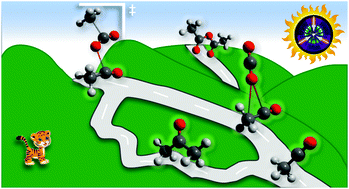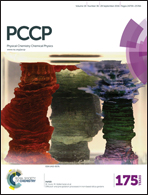Bifurcated dissociative photoionization mechanism of acetic acid anhydride revealed by imaging photoelectron photoion coincidence spectroscopy†
Abstract
The fragmentation processes of internal energy selected acetic acid anhydride cations, Ac2O+, were investigated by imaging photoelectron photoion coincidence (iPEPICO) spectroscopy. The first dissociation channel leads to the formation of CH3C(O)OCO+ (m/z = 87) by a CH3-loss. The 0 K appearance energy (E0) was determined to be 10.289 ± 0.010 eV, in excellent agreement with the G4-calculated 10.28 eV transition state (TS) energy. Based on the thermochemical onset of CH3C(O)OCO+, a reverse barrier of 40 kJ mol−1 was found. The second dissociation channel leads to the formation of the acetyl cation, CH3CO+ (m/z = 43). The appearance of trace amounts of acetone in the mass spectra, statistical modeling of the branching ratios, and quantum chemical calculations point to the existence of a post-transition-state bifurcation on the potential energy surface and a single TS leading to multiple products. That is, at higher excess energies, the CH3-group may swerve back along an orbiting pathway to form the acetone cation by CO2-loss instead of leaving directly. The acetone cation thus formed is then energetic enough to lose a methyl group and yield the acetyl cation at a phenomenological E0 = 10.316 ± 0.015 eV. The acetyl cation, which dominates the breakdown diagram up to 16 eV photon energy, is also formed by sequential CO2-loss from the CH3C(O)OCO+ intermediate at E0 = 10.53 ± 0.03 eV. The CH3+ (m/z = 15) fragment ion appears above 13 eV photon energy. This species can be produced directly from the parent ion or via two sequential dissociation channels: by acetyl radical loss from the acetone cation or CO-loss from the acetyl cation.


 Please wait while we load your content...
Please wait while we load your content...